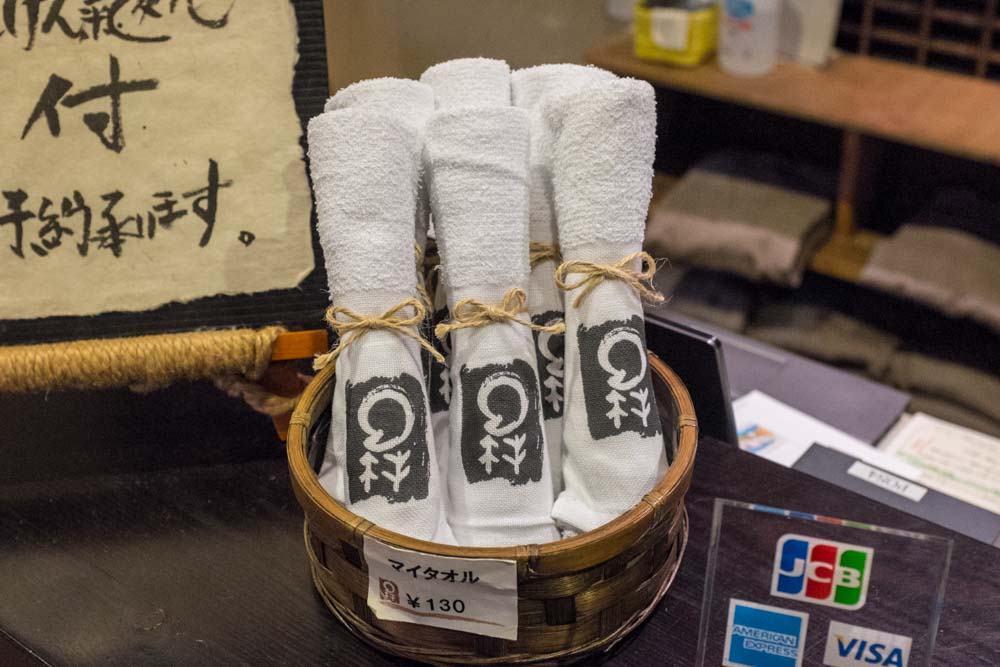Visitors to Japan are sometimes hesitant to try the hot springs because they don’t know the correct etiquette or protocol for entering the baths. This is especially understandable at the day onsen where foreigners are not often seen. But don’t worry, it’s not all that complicated—and with a couple of things to bear in mind you’ll be (almost) blending in before you can say “onsen”.
Entering the Day Onsen
First of all, the day onsen are in many respects quite traditionally Japanese places, adhering to a few of the more well-rooted cultural customs. When you first enter the building there will be an area to remove outdoor shoes called a tataki (三和土). Like Japanese homes, shoes are not allowed in the building. Very close by you’ll find lockers in which to place your shoes (your other belongings you can take with you). Some places may have coin lockers but you should get the money back at the end.
The Reception
At some day onsen you will pay at the reception; others may have a vending machine where you purchase tickets (this will almost definitely be in Japanese only, so ask a member of staff if you’re not sure). Here you pay your nyūyokukin (入浴金)—entrance fee to the baths. If you see many different options on the price list or buttons on the vending machine, these will be for additional services like the hot stone spa or massage—or, in some cases, towels. Most of more expensive day onsen include a small towel as part of the entrance fee, but the the more local onsen will expect you to bring your own. If you don’t have one, you’ll be able to purchase or rent one for a couple of hundred yen. At some day onsen you will also hand over your shoe locker key for staff to keep until you want to go home. In exchange, you’ll be given a locker key for the changing rooms.

The Baths
The baths are separated by sex (typically blue for men; red for women). The changing rooms themselves are like any other, with the exception that many onsen provide earbuds, hair dryers, and even skin lotion in the dressing area.

You enter the baths naked (no swimwear allowed—if you do enter with swimwear you will almost definitely be asked to remove them by a member of staff), taking only your hand towel with you. This is used to cover yourself as you wander around the baths, as well as to wipe the excess water from your body before you head back into the changing rooms afterwards.
The first thing you’ll see when you enter the baths is the kake-yu—a tub of warm water near which you’ll find a wooden ladle. You use this to pour water over your body and cleanse yourself before entering the baths. Remember, the baths at the onsen are for relaxation and soaking away the wears and tears of the day; they are not for cleansing your body. For that there is the kake-yu and shower area, where you should wash yourself before entering the baths.

These are not private shower cubicles like you would find at sports gym, but open lines of showers each with a small stool and plastic bowl. Japanese wash themselves while seated on the small stool. The plastic bowl is for shaving. The faucet can be switched to work as a tap to fill the bowl (for shaving).
Now you’re ready to enter the baths! There is no correct order or anything like that—just go in and out as you please. You can read more about the different type of baths you may find at the day onsen here, but remember the following manners:
- Carry your hand towel with you but do not put it in the bath water. You’ll see many Japanese fold it up and place it on their heads when in the baths (which, incidentally, has a nice cooling effect when you’re soaking in the open-air baths). Otherwise place it on the side of the tubs.
- Do not splash around or swim inside the tubs (some of them can be large enough to at least paddle your way from one end to the other)
- Do not make too much noise. Chatting with friends is obviously fine, but many customers go there as individuals to relax so please be considerate.
- If you’ve got long hair either (1) tie it up, (2) wrap your towel nicely around it, or (3) use a shower cap.
- Do not wipe your body down with your towel while in the bath tubs. Cleanse in the showers; relax in the tubs.
- After you use the sauna or steam rooms, wash the sweat away at the kake-yu or shower area before re-entering the baths.
- Generally be aware that others want to use the baths, as well. This doesn’t apply to the main baths, but you do get one-man pot-tubs and the like. Limit your time in these to 10-15 minutes so other customers can have a turn, as well.
- When you go back to the changing rooms, wring your hand towel and wipe the excess water from your body.




